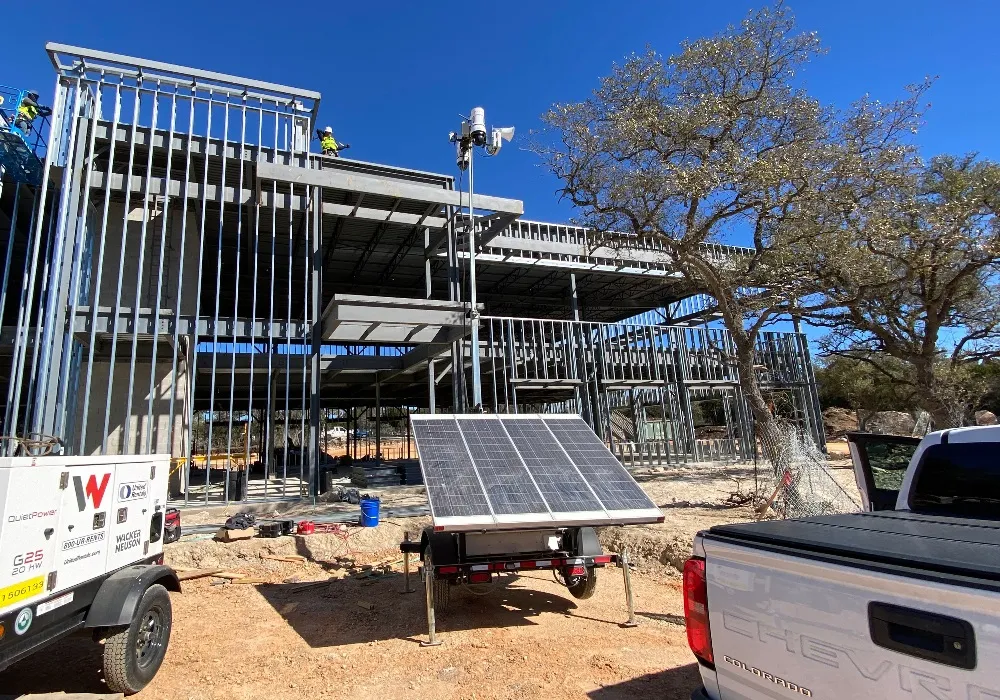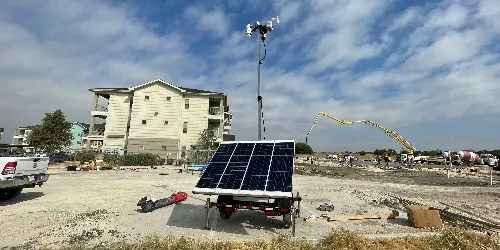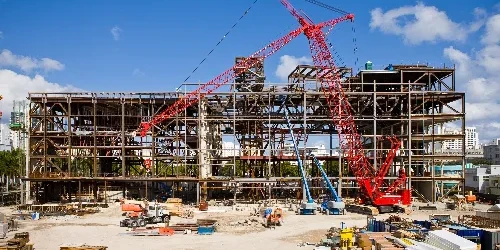Construction jobsites attract a range of security and safety challenges, including the threat of vandalism, trespassing, and theft of equipment and materials.
Reports previously showed that construction site theft accounts for approximately $1 billion in losses annually in the U.S alone.
Combining the financial implications created from vandalism, accidents, and other security risks with theft, construction crime has costly consequences for businesses and the delivery of the project.
In response to these statistics and growing threats, we created a comprehensive guide on construction jobsite security, aimed to provide site managers with a step-by-step process on securing your site, from ground-breaking to client handover.
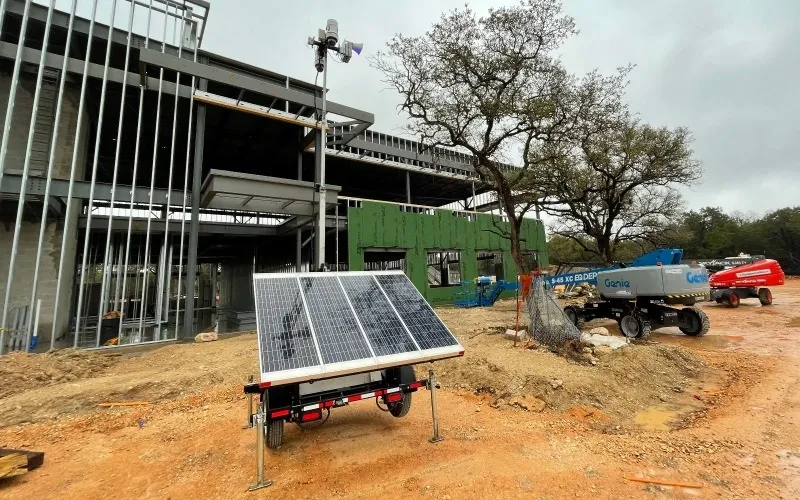
About the Construction Jobsite Security Guide
Our objectives in creating this guide are simple: to help construction companies reduce losses attributed to crime, whether these are monetary losses from vandalism, asset theft, or the costs of project delays.
The authors of this document have a combined 30-years of experience working alongside construction companies across the globe, supplying the highest quality security services and surveillance cameras.
What's in the Guide?
While this guide has been created for companies of any size, the location and layout of your site, as well as the project duration, will dictate what types of security measures you require.
Any advice in this guide can be used as a 'rule-of-thumb' and may be adapted to your site-specific requirements.
Topics covered include:
- Hoardings and Fencing
- Doors and Gates
- Site Offices
- Lighting
- Surveillance Cameras
- Plant and Tools
- Urban Explorers
- General Advice
- Expert Systems
Our Comprehensive Guide on Construction Jobsite Security
Are you sure your jobsite is safe? Have you considered all the necessary factors in your security?
Below details each step your site can take to better your security and protect your construction jobsite against security risks like theft, vandalism, and workplace accidents:
Hoardings and Fencing
When designing site hoarding, it is advisable to consider security details such as creating sharp corners or alcoves. These give a potential site intruder a natural hiding spot. Instead, look to create rounded corners wherever possible, and avoid creating blind spots.
Pedestrian and vehicle entrances to your sites create a natural security weak spot around your site perimeter. It would be wise to focus on these areas to ensure these structures don't give unauthorized intruders access to your sites.
Keep an eye out for potential footholds or steps that would present an opportunity for intruders to scale your hoarding or fences.
Intruders can use streetlights and electrical junction boxes surrounding your jobsites to help them climb over fencing or hoarding.
To negate this threat, set your hoarding or fences back from any of these fixed structures.
If hoarding must be positioned flush with streetlights, take extra care to reduce the creation of natural footholds. Using a smooth transition made from plywood will help minimize the threat of someone easily climbing the hoarding by eliminating natural footholds.
Keep the areas surrounding your hoarding and fencing clear from debris, building materials, and any waste. This also provides intruders with potential access which you should look to avoid.
Angled extensions (‘fans’) on top of hoardings make climbing difficult and reduce problems with items (including litter) being thrown over the hoarding and potentially damaging materials or injuring workers.
Ideally, your hoarding should be no less than 8 ft high to prevent anyone from easily seeing into your sites, or climb over it easily.
You should ensure you have a regular maintenance program in place to clear any graffiti off the hoarding because the more that is present, the more other crime types are likely to occur.
Hoarding must be regularly inspected to ensure its continued integrity and should be modified as required during the course of construction works as site requirements change.
Doors and Gates
It is advisable to keep the number of site entrances to a minimum to reduce the likelihood of an unauthorized intrusion, and to help better manage the flow of authorized access.
It would be best to communicate your site operating hours to all workers, including subcontractors and suppliers, on a frequent basis.
Having set and clear working hours will make it easier to detect when there is unauthorized entry onto your site.
Having a 24/7 security protocol in place can help reduce opportunistic theft. This security presence can be guards or surveillance cameras, or a combination of the two.
Have a clear policy for site access, like screening any visitors before they enter. This will ensure only authorized visitors will be onsite and minimize any security risks.
For smaller sites, you can have a sign-in book at the site entrance.
Or for larger sites, access may be controlled by a security guard with a sign-in system or by electronic access control systems such as PIN codes, electronic fobs or cards, or vehicle LPR scanners.
Biometric access control systems may be an option also, though, for many sites, they can be unnecessary, overly-complex, and create logistical issues when trying to read fingerprints of tradespeople.
Turnstiles are a good way of controlling access to a site, especially when paired with an electronic access control system.
Your gates should be constructed with minimal space underneath to prevent any individuals from crawling under.
You also need to ensure any gates reach the height of any hoarding or fencing in place, so that intruders don’t have opportunity to scale over this either.
The gates or doors chosen need to match the requirements of your site, and any hinges should be secure, and difficult to unscrew from the outside. These need to be fixed to prevent the gate from being lifted.
Chains should be of an appropriate length, not excessively hanging down. The majority of the chain should be on the secure side of the gate in case this can be taken advantage of by any potential intruders.
Site Offices
Site offices should be constructed in a way that prevents them from arson and burglary. Steel construction, secure doors with multiple locks, and window shutters secured from inside are highly recommended.
Limit the number of people who have access to keys, utilize a key safe, and have a system for signing keys in and out.
You should also implement a policy of issuing security passes, and foster a culture of challenging anyone not wearing one to create ongoing vigilance onsite.
Lighting
Lighting helps deter site intruders, assists security patrols, and makes the area feel safer at night.
Your site hoardings should have a uniform lighting level on the exterior to illuminate the entire perimeter.
Lighting inside the site should also be of a uniform level. While high-powered spotlights can light up specific areas, they also create pools of dark areas where a site intruder can take advantage of.
Utilizing low wattage lighting throughout the site will eliminate these areas of high contrast.
Any lights on the outside of your hoarding should be tamper-proof, and regular maintenance should be scheduled to ensure ongoing operation.
Wiring for site lighting should only be accessible to authorized personnel. This is particularly important for bulkhead-style lights employed on the exterior of the perimeter hoarding. Exposed lighting cables should be enclosed in a steel conduit.
Any recesses or hidden points on your site should have particular attention paid to them with lighting and mirrors to increase visibility.
Surveillance Cameras
Temporary surveillance cameras are one of the most effective ways to deter crime from construction jobsites.
Cameras should be positioned to achieve recognition quality and in such a way that site lighting does not interfere with picture quality.
Most systems utilize remote monitoring services that assess any threats from your live video feed and respond to them appropriately. This provides a proactive and reactive approach to security.
Your lighting should complement surveillance cameras, ensuring that both are positioned to avoid glare on the camera.
Modern surveillance cameras provide infrared (IR) or low lux capability which are ideal for construction jobsites. This is because nighttime is when sites are most vulnerable to crime such as machinery and copper theft.
Mobile security systems like Surveillance Trailers work best for construction sites. They are easily relocatable, so as the site progresses and camera position needs to change, the system can be adjusted to this.
For a large site, consider a License Plate Reader (LPR) enhancement to your surveillance cameras. This is an effective way to manage vehicles entering the site and monitoring any unauthorized vehicles that may attempt to gain access.
Surveillance cameras with solar powering and wireless (cellular) transmission are increasingly popular solutions for jobsite security due to their flexibility and cost-effectiveness.
The other main benefit is that you can customize your surveillance cameras to suit your jobsite, increasing their effectiveness and preventing crime from delaying your project.
Plant and Tools
All vehicles and plant should have ignition keys removed and, if possible, be immobilized at the end of each day.
Keep a record of all Vehicle Identification Numbers (VIN), chassis, and engine numbers for any vehicle being used onsite.
Securely mark all plant with a unique reference to aid retrieval in case of theft. Some schemes record details of members’ items, making it easier to identify and return if stolen.
Any electrical infrastructure that could be used to commit thefts should also be disabled at the end of each working day. This includes generators and transformers used that supply power to cutting tools.
Communicate with all contractors and personnel onsite to mark their tools to help protect themselves also. Painting tools with unusual colors and covert methods such as permanent marking inside drill housings make it easier to return stolen items.
You can utilize forensic property marking systems. These invisibly mark your valuable items, making it easier for Law Enforcement to recover them.
If tools are to be left onsite overnight, use a tool safe or other high-security storage sheds.
Tracking chips and internal security systems that render the tool inoperable by anyone other than the authorized user are now available too, and make them invaluable to criminals.
Spot check vehicles leaving the site to mitigate against them being used to convey stolen goods from your construction project.
You can also implement surveillance cameras to monitor specific machinery locations and tool sheds to ensure additional protection against crime like tool theft.
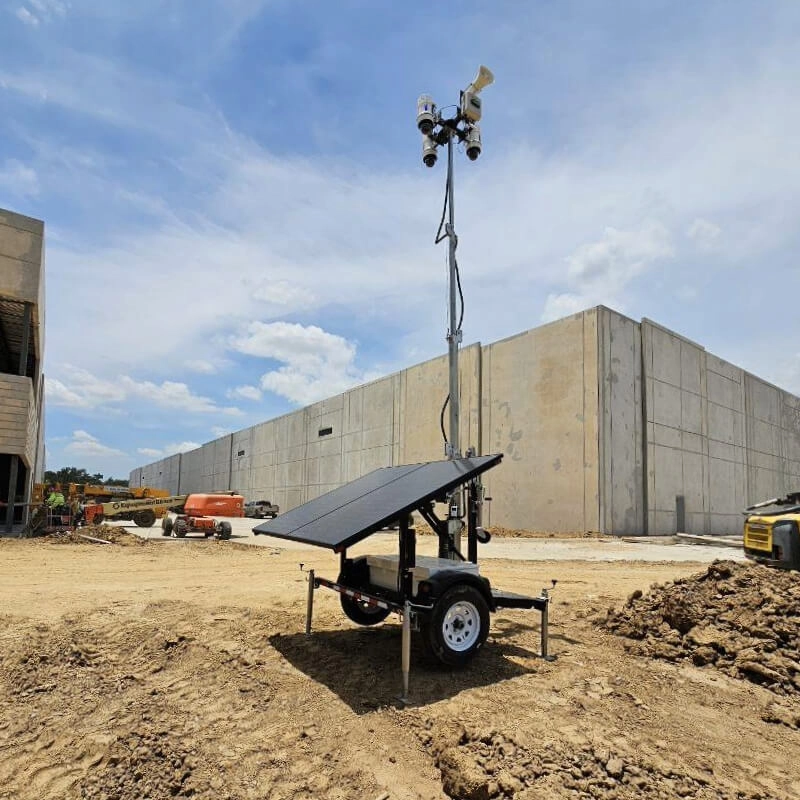
Urban Explorers
Urban Explorers are groups of people who explore urban structures such as abandoned sewers or underground railways or the roofs of skyscrapers.
The following is a non-exhaustive list of things to consider with regards to identifying Urban Explorers:
- Individuals or groups looking for access points (perimeter fences, doors, access panels or vents).
- Individuals or groups emerging from drains or buildings after dark.
- Carrying daysacks/rucksacks to hold their camera equipment as well as access equipment (bolt cutters, skeleton keys, lock picks, ropes, etc.).
- Possession of a Drone.
- Known to wear hi-visibility clothing to look official.
- They generally operate during hours of darkness but will often carry out reconnaissance during daylight hours.
- They are security-aware and have been known to distract security staff multiple times until they stop responding before entering locations.
- Known to befriend security to gain access without site owners’ knowledge or permission.
- Will try to talk themselves out of trouble when stopped, saying ‘only taking photos’.
The groups are known to have caused damage to gain entry to sites, and on some occasions have suffered serious injuries. The disruption to construction jobsites should this happen is severe, and can lead to lengthy investigations which will ultimately incur high costs.
Infrared surveillance cameras backed by video monitoring greatly assist in the detection and deterring of Urban Explorers..
Anti-climb paint in vulnerable areas, particularly any place where a climbing rope could be utilized, will put off an Urban Explorer. Should this be employed, adequate signage should be used, as anti-climb paint can cause considerable damage to expensive climbing ropes.
Forensic property marking spray systems are now available as a crime prevention method. There are various products that will transfer onto offenders.
General Advice
You should aim to build a culture of challenging anyone onsite who should not be there, or does not have the correct ID.
All security personnel working onsite must be contracted to do so and be appropriately trained and briefed on any particular vulnerabilities of your specific site.
Employees should be taught how to report suspicious behavior to security or Law Enforcement and report any thefts immediately.
And as a business, displaying warning notices of the security measures in place can help ward off opportunist thieves.
Valuable building materials should be stored securely and protected by surveillance cameras, security patrols, and intruder alarms.
Hold regular security briefings, particularly as the site develops and new teams join to ensure you continue to foster a culture of security during the full project.
Managed Security Cameras for Construction Jobsites
WCCTV is the USA's leading supplier of mobile surveillance cameras for construction jobsites.
We provide world-class security cameras backed by a fully-managed service that includes equipment installation, video monitoring, maintenance, and ongoing technical support.
Our rapid deployment cameras provide construction jobsites with multi-application benefits, including security, Time Lapse Video filming, and remote project management.
Our customizable solutions can accommodate any site, and easily function whether you have power or are dependent on solar energy.
All of our units contain 4G/5G transmission technology – allowing these solutions to operate autonomously and without any need for mains power or internet.
No matter the site, we can create the solution for you.
